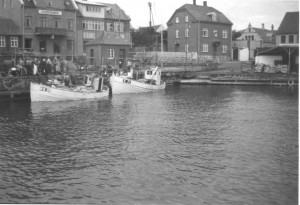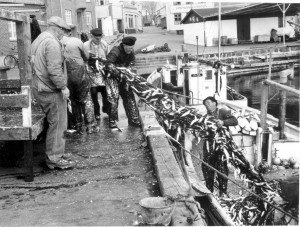 The first steps to build a harbour in Allinge were taken in 1837, and it was no simple feat.
First, the workers had to drill explosives deep into the rock, blasting away large chunks into the sea just to create the initial modestly sized and usable harbour basin.
The first steps to build a harbour in Allinge were taken in 1837, and it was no simple feat.
First, the workers had to drill explosives deep into the rock, blasting away large chunks into the sea just to create the initial modestly sized and usable harbour basin.In the years leading up to 1858 an expansion of the harbour became necessary, but there was no way it could have been secured from the violent storm in 1872 that completely destroyed the harbour, throwing even large ships onto land and wrecking them. It took four years for the harbour to be rebuilt.
 Anyone who has experienced a true “northeast menace” wind in northern Bornholm can imagine the carnage.
Anyone who has experienced a true “northeast menace” wind in northern Bornholm can imagine the carnage.However, the harbour was still used for fishing, and it was often a good spot to catch salmon in the winter as well as herring and cod in the spring and summer. In the summer, the boats would sail out around 4pm and return around 2am.
If they had brought back a large haul, the wives and older children would be woken up to help empty the nets of the “gold of the sea”.
In July, locals would buy “lægjasijl”, or herring that was for salting, allowing it to be kept in food stores for a long time.
 Together with smoking, salting was the main method of food preservation back then.
Together with smoking, salting was the main method of food preservation back then.When people went out to buy “lægjasijl”, they would bring a wheelbarrow or straw basket with bitter dock leaves covering the bottom to haul back the herring.
The herring was then smoked in the many large and small smokehouses across the island to make them last longer - and taste well, of course.
This was before the time of engines, which meant that the fishing boats had to rely on sails and accordingly the wind and weather.
When the wind wasn’t blowing, the fishermen had to row their boats into the harbour, sometimes only arriving in the late morning to crowds of people waiting with their herring baskets.
Read the fisherman’s daughter’s story of what it was like to get up at night to help out (see QR code no. 3).



